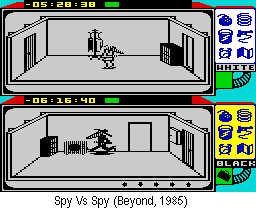|

By Lloyd Mangram
August
1985
Issue 19
|
|
The
Spectrum surfer cover has some things in common with
Issue Eight's, the man diving into a pool: the cool
blues of water, the surreal use of a computer as a surfboard.
It heralded the arrival of the Spectrum + at the height
of summer. The primary task of a magazine cover is to
stand out from the plethora of other titles on the newsagant's
shelves. When it came to using colour, strangely juxtaposed
images and dynamic composition, Oliver Frey's CRASH
cover pictures were, and still are, among the best.
They always make an immediate impact.
|
Surfers dice with danger in their sport; the cover was an
apt symbol for the issue. In a fit of self-righteousness -
which to be honest had always lain just under the surface
of CRASH’s editorial stance, sometimes threatening to break
out but usually contained - new Editor Graeme Kidd and his
small team set aside four pages to lampoon rival magazine
Sinclair User. And in a wave of what proved to be ill-judged
enthusiasm for the project, everyone involved from editorial
to art dived in to make it a perfect lampoon.
Events turned sour when Jeremy Spencer handed Sinclair User's
editor an advance copy of the issue. Within hours, Sinclair
User's publishing company, East Midland Allied Press, sought
an injunction to prevent the issue being distributed. As many
of the events which took place thereafter are still sub judice
(going through the legal process), it is not possible to mention
them here.
EMAP won its injunction and the issue had to be recalled,
the four offending pages trimmed and a sticker placed on the
cover stating briefly why they were missing before the magazines
could be redistributed.
To avoid the possibility of a libel suit being filed against
Graeme Kidd and Newsfield, the matter was settled out of court,
and in the Christmas Special we printed an official apology.
Ironically, public feeling about all these goings-on appeared
to run in CRASH’s favour and whether or not it had any bearing
on the matter, from that moment on the magazine's circulation
spiralled rapidly upwards, from around 50,000 copies a month
to over 100,000.
But before all this took place, while the edition was being
prepared, the CRASH team treated themselves to some more innocent
fun. Part Five of the Sinclair Story which we had been running
dealt with Sinclair’s battery car, the C5. Seen as risible
in many quarters, the C5 found an unlikely home in Ludlow
when a local car-hire firm purchased several to act as sight-seeing
buggies for the tourists who flock to the town every summer
- strange when you consider how hilly Ludlow is, and therefore
how much pedalling the tourists had to do to help the motor
cope with the strain!
For the article several CRASH reviewers went down to the
car-hire firm and took the C5s out for a reviewing trip. The
resultant buggy wars on the market car park did a lot for
the C5's reputation among CRASH staff, but sadly failed to
save it from its ultimate fate of obscurity.
 More
germane to the magazine, though, Ocean gave us the Spectrum
version of Frankie Goes To Hollywood, all icons, windowing,
spoof games, puzzles and highly creditable graphics; what
with this and Beyond’s Spy Vs Spy with its simultaneous
split-screen presentation, it looked like hit games from now
on were going to have to be complex and sophisticated to succeed
- though of the two other Smashes, Imagine's Hypersports
was really more of the same only better done, and Nodes
Of Yesod was more of a different same only done superlatively
by Odin. More
germane to the magazine, though, Ocean gave us the Spectrum
version of Frankie Goes To Hollywood, all icons, windowing,
spoof games, puzzles and highly creditable graphics; what
with this and Beyond’s Spy Vs Spy with its simultaneous
split-screen presentation, it looked like hit games from now
on were going to have to be complex and sophisticated to succeed
- though of the two other Smashes, Imagine's Hypersports
was really more of the same only better done, and Nodes
Of Yesod was more of a different same only done superlatively
by Odin.
A newcomer's advert is likely to arouse curiosity and Odin's
was very classy. It ran for two months before the game's release,
but Odin wasn't really as virgin as everyone thought, it was
just another name for Thor, whose high-tech Liverpool offices
were situated immediately opposite the sad-looking, derelict
windows of Bug-Byte - in the midst of death, there's life
. . .
|